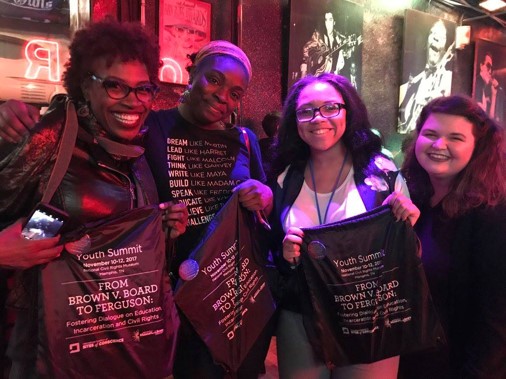
Today’s preview of a session that will take place at #AAM2018 is contributed by Tramia Jackson, Program Associate, Methodology and Practice, International Coalition of Sites of Conscience. You can scan all the sessions featured in CFM’s Guide to the Future at AAM 2018 in this earlier post.
Mass incarceration is the human rights issue of our time. Over 2 million men and woman are incarcerated in prisons, jails or detention centers, a disproportionate number of whom are people of color. Families of incarcerated men and women deal with weakened family bonds between children and parents, loss of income, financial costs for visits, expensive prison phone calls, and bail fees. Communities that spend the most on policing and incarceration strategies often do not have adequate resources to support reentry programs or to address the critical root issues of education access and poverty. As a result these communities are likely to see an increase in crime despite their focus on criminal justice and public safety. As state and federal governments grapple with criminal justice reform, museums have a unique opportunity to engage those most affected – young people entering the system, currently and recently incarcerated citizens, and those closest to them – in thoughtful ways.
The Center for the Future of Museums TrendsWatch 2017 recommends that museums become places for dialogue, healing and advocacy to address this issue and its negative effects on their communities. At the International Coalition of Sites of Conscience (the Coalition) we have worked with sites leading difficult conversation on social justice issues for almost twenty years. Today our member sites are working in partnership with eleven communities across the US to engage in these conversations through projects like our IMLS-funded program, From Brown v. Board to Ferguson: Fostering Dialogue on Education, Incarceration and Civil Rights, which encourages participating sites and their community partners and youth participants to create dynamic public engagement programs with the goal of fostering dialogue on race, education equity and incarceration in the context of civil rights history.
Through programs like From Brown v Board to Ferguson and our global Internment, Institutionalization and Incarceration working group, Coalition sites are working to move visitors to create change around the school to prison pipeline and mass incarceration. The Museum of International Folk Art established a partnership with the Bernalillo County Metropolitan Detention Center bringing the Inaugural Poet Laureate of Albuquerque New Mexico, Hakim Bellamy, to the Center to conduct art-based dialogues with women enrolled in a GED program at the detention center. Eastern State Penitentiary Historic Site hires returned citizens to give tours and has implemented changes in their human resource practices, changing their job application forms to reflect Ban-the-Box initiatives. The Museum of Tolerance offers From Hate to Hope, a program which highlights the story of healing and forgiveness between a returned citizen, Tim Zaal, who was once convicted of hate crimes and his victim, Matthew Boger.
Each of these Sites of Conscience are engaged with the criminal justice system in ways that reflects their mission, resources and capacities, and this is work that many other museums and historic sites can be engaged in as well. Join us to speak with these member sites and explore your own ideas for social action on incarceration and criminal justice work in the context of museums and community at Engaging the System: Museums Working in the Incarceration Systemon Monday, May 7, from 1:45 – 3:00 pm. We look forward to creating change with you.
Panelists
Lauren Zalut – Director of Education and Tour Programs at Eastern State Penitentiary Historic Site
Linda Blanshay – Director, Program Development at the Museum of Tolerance
Patricia Sigala – Educator/ Community Outreach Coordinator at the Museum of International Folk Art
Tramia Jackson – Program Associate, Methodology and Practice at the International Coalition of Sites of Conscience
 |
Youth from all over the U.S. gathered together with participating museums and community partner organizations at the From Brown v. Board to Ferguson Youth Summit in Memphis, Tennessee at the National Civil Rights Museum in November 2017. Valerie V. Gay (Executive Director of Art Sanctuary), Blessing Osazuwa, Kamryn Davis and Samantha Hunter (Education Specialist, Eastern State Penitentiary Historic Site) make up the team from Eastern State Penitentiary Historic Site. They are currently developing dialogue based programs around mass incarceration, race and policing to be launched at Eastern State Penitentiary later this spring.








